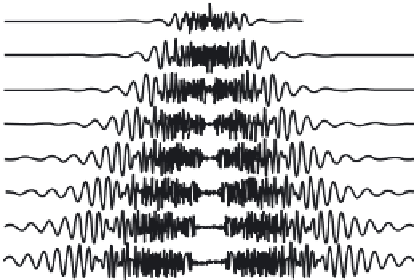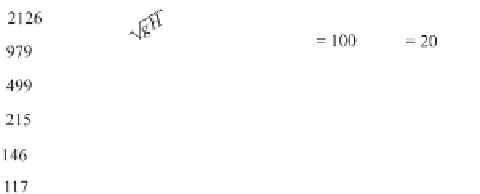Geoscience Reference
In-Depth Information
Ti
(min)
(m)
Oc
Am
I
I
I
3,
Fig. 4.19 Dynamics of wave perturbation at long times (Adapted from [Ward, Asphaug (2000)])
seen to correspond to the most short-period region of the tsunami spectrum. This fact
is essentially reflected in the character of cosmogenic tsunami propagation. Unlike
waves of seismotectonic origin, co
smo
genic tsunamis have no fronts propagating
with the velocity of long waves,
√
g
H
. From Fig. 4.18 their spectrum is seen just
not to contain components of the necessary wavelength (
kH
<
0
.
1). As to the com-
ponents carrying energy they will propagate significantly slower (about two times
slower in the case of
R
C
=
H
), than usual seismotectonic tsunamis.
Straightforward calculation of waves for long times, the results of which are
shown in Fig. 4.19, confirm the arguments presented above. At the point, corre-
sponding to the position of the front of a long wave, no visible signal is present. The
wave packet, in which the long-wave components lead at long times, propagates
with a velocity more than two times inferior to the velocity of long waves. Here,
the amplitude of waves rapidly decreases with time and distance from the area of
origin. Thus, while at the 3rd minute after the impact of the celestial body the am-
plitude amounts to over 2,000 m, in 27 min it no longer exceeds 70 m. And then,
waves of noticeable amplitude only have time to cover 100 km. Note that in 27 min
long waves cover distances of over 300 km.
Analysis of numerous calculations have permitted the authors of [Ward, Asphaug
(2000)] to propose a formula describing the damping of cosmogenic tsunamis with
distance in an ocean of constant depth. These calculations show that variation in
the wave amplitude is only related to geometrical factors and phase dispersion.
Dissipative factors and the Earth's sphericity are not taken into account. More-
over, the assumption is made that, independently of the characteristics of the ce-
lestial body falling into the ocean, the initial wave amplitude cannot exceed the
ocean depth.
ξ
max
(
r
)=min(
D
C
,
H
)
1
1 +
r
/
R
C
γ
,
(4.50)























